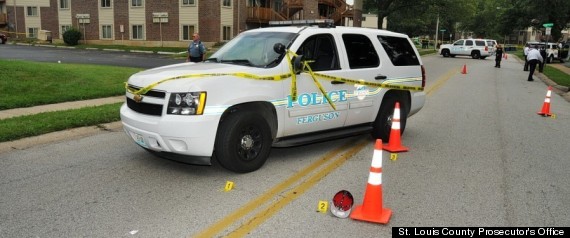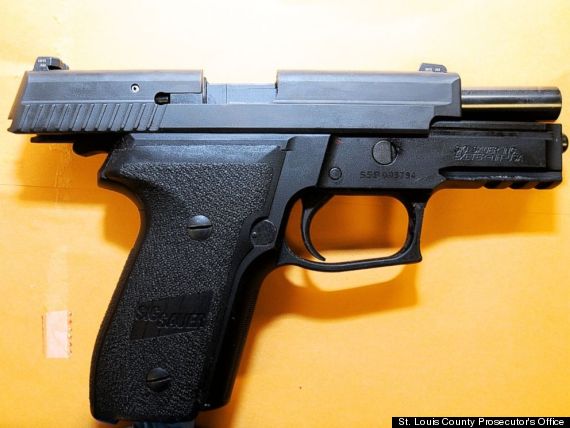Lol, the breadth and depth of your ignorance is astounding! You actually think, actually believe, that you found something that the prosecutors didn't? Your stupidity is a never ending source of amazement.
Navigation
Install the app
How to install the app on iOS
Follow along with the video below to see how to install our site as a web app on your home screen.

Note: This feature currently requires accessing the site using the built-in Safari browser.
More options
You are using an out of date browser. It may not display this or other websites correctly.
You should upgrade or use an alternative browser.
You should upgrade or use an alternative browser.
Michael Brown was 148 feet from Wilson as he was shot to death
- Thread starter Statistikhengst
- Start date
orogenicman
Darwin was a pastafarian
- Jul 24, 2013
- 8,546
- 834
- 175
He was 148 feet away and Wilson managed to get two head shots on the boy with a police issue Glock? Wow, that's amazing. Oh wait...
You've been fooled by a photo/meme, and a bad one at that. Officer Wilson was carrying a .40 caliber Sig-Sauer P239 handgun at the time of the shooting. I've also seen several photos and other images depicting a Glock, but from what I've read that is not the firearm he was carrying.
Glock, Sauer, whatever. Doesn't matter. He simply did not shoot the man twice in the head rapid fire from 148 feet with a handgun. Didn't happen.
3 bullet casings found close to browns body
evidence the distance between the two which was much MUCH less then 148 feet
Or that Wilson picked up his brass and moved it.
With 40 onlookers, at noon on a residential street and none of the witnesses reported seeing this movement.
Delusional much?
Delusional a LOT.
jon_berzerk
Platinum Member
- Mar 5, 2013
- 31,401
- 7,368
- 1,130
3 bullet casings found close to browns body
evidence the distance between the two which was much MUCH less then 148 feet
Or that Wilson picked up his brass and moved it.
quit lying liar
jon_berzerk
Platinum Member
- Mar 5, 2013
- 31,401
- 7,368
- 1,130
3 bullet casings found close to browns body
evidence the distance between the two which was much MUCH less then 148 feet
Lefties have made up their minds, facts won't deter them.
yeah like joe
and make up their own facts
jon_berzerk
Platinum Member
- Mar 5, 2013
- 31,401
- 7,368
- 1,130
"The community" demanded a grand jury since they were not allowed to lynch Darren Wilson.The dolts on the left watch too much crime TV!!
Mental cases........shit should never even gone to the grand jury.
they wanted a grand jury because they didnt trust the prosecutor
now that the grand jury returns in favor of the officer
they want the prosecutor to go into action
--LOL
3 bullet casings found close to browns body
evidence the distance between the two which was much MUCH less then 148 feet
Or that Wilson picked up his brass and moved it.
With 40 onlookers, at noon on a residential street and none of the witnesses reported seeing this movement.
Delusional much?
much
--LOL
We already know that lefties are NEVER interested in the truth.
No the fucking truth asshole is that no kid should be shot down in the street for stealing cigs and punching a cop.
Nope, he should instead be beaten severely about the head and shoulders......
The forensic evidence supported Darren Wilson's version of the events. You disagree, forensics says your wrong. Why do you lefties hate science anyway? Is it because facts are unfeeling? Facts can't be coerced into changing due to skin color? Facts tell the truth?
the Forensics only proved he wasn't shot in the back.
they don't show if he had his hands up when the bullet went through his skull. there's no way to tell that, forensically.
How simple minded you are.
Pointing out he obvious. Which "Forensic" test proved his hands weren't up when the last bullet entered his brain?
Oh, wait. YOu don't have one of those.
What you did have were 16 witnesses who said his hands were up.
I bet you think anyone that has had a family member killed by a black should be excluded from police work, law school, or elective office, don't you?
No, but they should recuse themselves from cases involving race. Such a person WOULD have been excluded from a jury.
[
"The community" demanded a grand jury since they were not allowed to lynch Darren Wilson.
No, the community demanded a trial. Not the farce we got.
Roadrunner
Roadrunner
Get over it, your "hero" was a thug who brought on his own death.I bet you think anyone that has had a family member killed by a black should be excluded from police work, law school, or elective office, don't you?
No, but they should recuse themselves from cases involving race. Such a person WOULD have been excluded from a jury.
Roadrunner
Roadrunner
You have never explained how you get to a trial without a Grand Jury first.[
"The community" demanded a grand jury since they were not allowed to lynch Darren Wilson.
No, the community demanded a trial. Not the farce we got.
Or, did Obama issue an executive order voiding the 5th Amendment, and I missed it?
With 40 onlookers, at noon on a residential street and none of the witnesses reported seeing this movement.
Delusional much?
You mean the crime scene that the cops left the body in the street for hours, where they didn't file an incident report, where the coroner took no pictures because his camera battery was dead, where Wilson was allowed to drive his vehicle back to the station and enter his own gun into evidence, after being allowed to wash up without being photographed?
Get over it, your "hero" was a thug who brought on his own death.I bet you think anyone that has had a family member killed by a black should be excluded from police work, law school, or elective office, don't you?
No, but they should recuse themselves from cases involving race. Such a person WOULD have been excluded from a jury.
Non-responsive. McCollough had a bias and should have recused himself. and if a special prosecutor came to the same conclusion he did, it would have had more credibility
Roadrunner
Roadrunner
If IF were a skiff, we could all take a boat ride.Get over it, your "hero" was a thug who brought on his own death.I bet you think anyone that has had a family member killed by a black should be excluded from police work, law school, or elective office, don't you?
No, but they should recuse themselves from cases involving race. Such a person WOULD have been excluded from a jury.
Non-responsive. McCollough had a bias and should have recused himself. and if a special prosecutor came to the same conclusion he did, it would have had more credibility
Lol, the breadth and depth of your ignorance is astounding! You actually think, actually believe, that you found something that the prosecutors didn't? Your stupidity is a never ending source of amazement.
How about addressing the points he brings up.
You guys claim up and down the "Forensics" back Wilson, and then ignore the fact that the investigation and evidence gathering was sloppy.
You have never explained how you get to a trial without a Grand Jury first.[
"The community" demanded a grand jury since they were not allowed to lynch Darren Wilson.
No, the community demanded a trial. Not the farce we got.
Or, did Obama issue an executive order voiding the 5th Amendment, and I missed it?
Actually, he totally had the option to get charges without a grand jury. He just wanted someone else to share the blame.
Statistikhengst
Diamond Member
- Thread starter
- Banned
- #118
The evidence was put in front of the Grand Jury.
Many witnesses were involved.
The Grand Jury found Wilson was innocent of wrong doing.
No. False.
The Grand Jury claims to not have enough evidence to indict.
There is a HUGE difference.
Statistikhengst
Diamond Member
- Thread starter
- Banned
- #119
I see nothing that says that a 239 cannot shoot 50 yards. In fact, most pistols can. Easily.
In fact, it would be a shitty pistol, or in this case, semi-automatic handgun, if you cannot fire a decent shot for at least 100 meters.
WOW. You have shown your absolute lack of knowledge of firearms very clearly. First off, the term "pistol" covers both semi-automatic handguns and revolvers. It's a more general term, as in this case neither revolvers nor semi-automatic handguns are EFFECTIVE at the range of 50+ yards. Then there's that word again "effective"; which means at what distance the firearm (even long guns) can be expected to be capable of easily hitting a target and providing sufficient stopping power to put the target down more often than not. A .40 caliber handgun is not EFFECTIVE at 50 yards. The probability of hitting the target and the stopping power at that range are very low. Especially with adrenaline running through the body. You asked for a link.... how about 15+ years of competitive action pistol shooting? Hell, standing at 50 yards and shooting at a man-sized target without the adrenaline and split-second decision making is incredibly difficult. Know what you're talking about before you open your mouth
Or, it can also mean that Williams lied about his position when he fired the shots.
I honestly don't care. Officer Wilson did the wold a service by removing Mike Brown from it. He should have gotten a commendation, not an inquisition.
Then why is this pistol used by the US navy, including navy seals?
And where is the link that specifies the range of said pistol?
Statistikhengst
Diamond Member
- Thread starter
- Banned
- #120
It's really simple to measure the distance, and quite accurately:
Those who measured started at the fire-hydrant that was near the police car from which officer Wilson fired the deadly shots:

Distance from the driver's side door (when officer Wilson claims he fired the shots) to the fire hydrant: 17 feet.
Distance from the fire hydrant to the spot where Michael Brown was standing when he was shot: 131 feet.
131 +17 = 148.
Now, there is an angle involved between the cop car and the hydrant, which means that actual distance of 17 feet, calculated as a straight line, will be somewhat less, maybe one third less. So, the true distance may be 140 to 141 feet. The angle represented by the yellow line looks to be about 35 degrees to the plain, if you consider the straight path of the sidewalk next to the hydrant to be the plain.
The police report says 35 feet. And a police officer said TWICE in a press conference that the distance was 35 feet:
(1:13 and 6:01)
35 feet and 148 are nowhere close to each other in terms of distance. 148 feet = 49 yards, or just about one-half of a football field.
The film clearly documents the start and end points, and they can be confirmed by police photos and photos shot by witnesses on that day.
35 feet could be an argument for immediate danger for a police officer. But 148 feet? No way.
Why did the Ferguson police lie about this detail?
And if the Ferguson police have lied about this, then we must ask what else they have lied about?
You know, sometimes it's all about simple math. The Ferguson police can lie for a while, but they cannot change geography and they cannot undo so many photos and videos.
Discuss.
Does a suspected perpetrator who is 148 feet away from an officer represent a danger to that officer's life?
That is not 130+ feet.
-Geaux
They just measured it. Did you not see the numbers?
Similar threads
- Replies
- 12
- Views
- 203
- Replies
- 45
- Views
- 752
- Replies
- 31
- Views
- 450
- Replies
- 1
- Views
- 102
Latest Discussions
- Replies
- 307
- Views
- 4K
- Replies
- 71
- Views
- 162
- Replies
- 241
- Views
- 982
- Replies
- 5
- Views
- 6
Forum List
-
-
-
-
-
Political Satire 8039
-
-
-
-
-
-
-
-
-
-
-
-
-
-
-
-
-
-
-
ObamaCare 781
-
-
-
-
-
-
-
-
-
-
-
Member Usernotes 468
-
-
-
-
-
-
-
-
-
-




